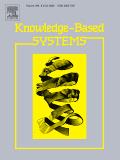- 投稿方式--官网投稿
-
期刊属性
-
- 中科分区:1区
- OA期刊:混合
-
- 综述期刊:否
- TOP期刊:是
-
- 期均国文:58
- 环比增速:-75.34%
-
期刊信息
- 研究方向:计算机科学-COMPUTER SCIENCE, ARTIFICIAL INTELLIGENCE计算机:人工智能
- 国际刊号:ISSN 0950-7051;EISSN 1872-7409
-
- 期刊语言:英语
- 出版地区:荷兰
- 投稿网址:https://www.editorialmanager.com/knosys
- 电子邮箱:
- 期刊官网:https://www.sciencedirect.com/journal/knowledge-based-systems
- 作者指南:https://www.sciencedirect.com/journal/knowledge-based-systems/publish/guide-for-authors
- 出版商网址:https://www.sciencedirect.com
- 出版地址:ELSEVIER SCIENCE BV, PO BOX 211, AMSTERDAM, NETHERLANDS, 1000 AE
- 期刊简介:Knowledge-based Systems《知识系统》(半月刊). Knowledge-based Systems is an international and interdisciplinary journal in the field of artificial intelligence.
-
万维提示
-
1、投稿方式:在线投稿。
2、期刊网址:
https://www.sciencedirect.com/journal/knowledge-based-systems
3、投稿网址:https://www.editorialmanager.com/knosys
4、期刊刊期:半月刊,一年出版24期。
2025年8月5星期二
外刊动态 更多
期刊点评
无费用期刊
- Discrete Analysis《离散分析》
- Chemical Industry & Chemical Engineering Quarterly《化学工业与化学工程
- ARP Rheumatology《ARP风湿病学》(原:Acta Reumatologica Portuguesa)
- ZFW-Advances in Economic Geography《ZFW:经济地理学进展》(原:Zeitschrif
- Yale Journal of Biology and Medicine《耶鲁生物学与医学杂志》
- Turkish Journal of Zoology《土耳其动物学杂志》
- Turkish Journal of Veterinary & Animal Sciences《土耳其兽医与动物科学杂志
- The Turkish Journal of Pediatrics《土耳其儿科杂志》
- Turkish Journal of Medical Sciences《土耳其医学杂志》
- Turkish Journal of Mathematics《土耳其数学杂志》
选择性费用期刊
- Reproductive Sciences《生殖科学》
- Rejuvenation Research《抗衰老研究》
- Die Radiologie《放射学》(原:Der Radiologe)
- Quarterly Reviews of Biophysics《生物物理学评论季刊》
- Psychiatry and Clinical Neurosciences《精神病学与临床神经科学》
- Preventive Veterinary Medicine《预防兽医学》
- Physics of Particles and Nuclei《粒子核物理学》
- Numerical Linear Algebra with Applications《数值线性代数及其应用》
- Nanoscale and Microscale Thermophysical Engineering《微/纳尺度热物理
- Matrix Biology《基质生物学》

